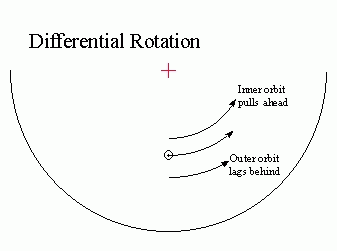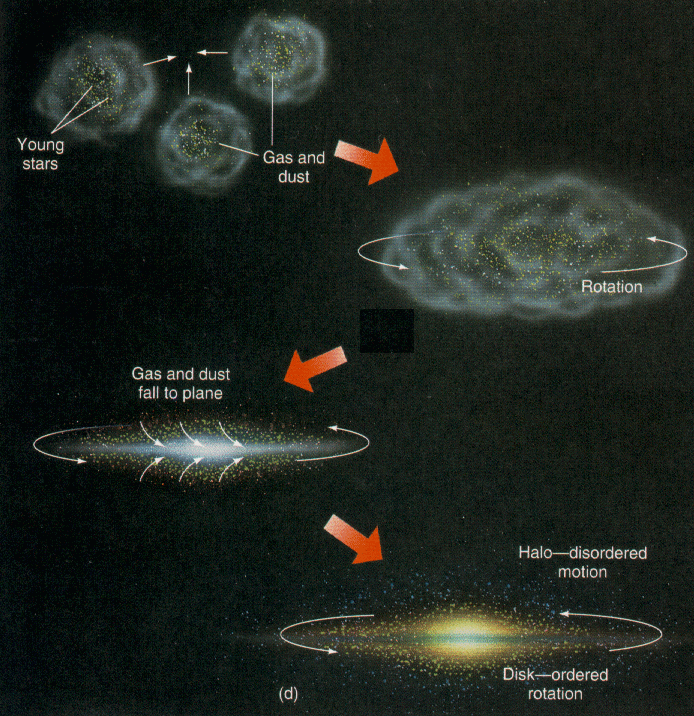| DATE |
Lecture
19 |
| TITLE |
Radio
Astronomy and Galactic Structure |
| READING |
Chapter
15 |
| MAIN
CONCEPTS |
Radio
Astronomy, Spiral Stucture |
COURSE
NOTES:
Radio Astronomy and the Galaxy
The problem with living in the middle of the Galactic
disk is that the interstellar medium blocks our view of most of the Galaxy.
We are very fortunate that there is a way around this, provided by radio
astronomy. This comes by way of the "21-cm" line, which arises from
neutral hydrogen. It is a special sort of energy transition, involving
a "spin flip" of the electron relative to the proton. The atom is in a
lower energy state when the spins are not aligned - the energy difference
is equal to a photon with wavelength of 21-cm. This transition is very
weak ( a typical interstellar atom can stay in the higher energy state
for millions of years), but since most of the Universe is hydrogen, this
radiation arises everywhere. Thus, the Galaxy is both transparent and visible
in 21-cm radiation.
The transparency makes it difficult to tell where
along a line-of-sight the detected emission is coming from. Because it
is a spectral line, one can make
use of the Doppler shift to help with this problem. In general, the
inner part of the Galaxy rotates at a different speed than the outer parts,
so there will be some projected velocity difference between gas at different
distances along the line-of-sight. Given a model for the Galactic rotation,
one can use it to assign each velocity bin in an observed broadened spectral
line to a different location. In this way, we can build up an overall map
of the neutral hydrogen. This map can be supplemented for nearby locations
by observing star forming regions containing massive stars; we know how
to assign distances to stars based on their main sequence location. Another
useful molecule is carbon monoxide (CO), whose rotational changes can also
give rise to radio photons. This is a good tracer of molecular clouds.
We end up with a somewhat
fuzzy impression of our whole Galaxy.

The picture which arises is that we live in a
flattened disk of stars and gas, which is organized into spiral arms. We
see many examples of similar structure for other galaxies. Indeed, the
nearest major galaxy, M31 in Andromeda, we think looks very much like the
Milky Way. The spiral structure may at first seem sensible, since the Galaxy
rotates at different rates at different radii, it would take radial structures
and wind them into spirals. The problem is that the spirals are never too
tightly wound, even though the galaxies have had time for up to 100 rotations.
The solution is that these arms are not composed of particular stars and
clouds; they are "density
waves". As on a freeway where there is an accident, the density of
cars behind and up to the wreck is much higher than in front of it, but
individual cars move through the density wave and then speed up away from
it. So stars, including our Sun, find themselves moving a little slower
while in the spiral arms and faster between them. The arms maintain themselves
by their own extra gravity, and serve the function of moving angular momentum
to the outer regions of the Galaxy, allowing it to slowly collapse. Due
to the higher density in the arms, this is where molecular clouds and star
formation tend to be concentrated. In other galaxies where we can look
down from above, the spiral arms are clearly traced out by the young bright
stars. Thus, we can use the locations of O&B stars, and HII regions,
to try to trace the spiral arms in our own Galaxy. These work nearby; 21-cm
observations are need for the far side of the Galaxy.
A
very nice version of most of this lecture can be found from Oregon...
The Galactic Nucleus
When you look at the center
of the Galaxy with an optical telescope you can't see anything because
of all the dust in the way. In order to see through the dust you have to
look at infrared and radio wavelengths because these waves are long enough
that they don't get scattered by the dust. Radio images of the center
of the Galaxy show a rotating disk of molecular gas about 5 parsecs across.
This is an accretion disk, where gas and dust being pulled towards the
center piles up. Just inside this disk is a spiral of hot ionized
gas which is falling in towards the middle and converging at the dynamical
center of the Galaxy. Near where the spiral converges there is an extraordinarily
bright spot of radio emission called Sgr A*. Astronomers think this is
a supermassive black hole. By measuring the velocities of stars and
gas orbiting Sgr A* we can measure its mass and we find that it has to
be about 2.6 million solar masses. The central mass has to be contained
in a region about 10 AU and the only way to put a million solar masses
in a region 10 AU across is if it is a black hole. As we study the
centers of other galaxies, it looks like supermassive black holes are pretty
common in the centers of galaxies on the whole. Black holes in the
centers of galaxies contain a million to a billion solar masses.
Here you can see stars orbiting our central
Black Hole (457kb animated gif).
Stellar populations
We divide stars up
into 2 groups, based largely on their time of birth. The characteristics
of each group are as follows: Pop I: young stars (1 billion years), have
circular orbits in the
disk of the galaxy, color
tends to be blue, they are metal-rich. Pop II: old stars (10 billion years),
found in the bulge and halo of our galaxy, orbits may be highly elliptical
and inclined to plane of galaxy, generally red, and metal-poor. Of course,
many stars formed in between 1 and 10 billion years ago and hence there
is a continuum of stellar properties, not a sharp division between Pops
I and II. The Sun is classified as a Population I star despite its
age, because it is metal-rich and has a circular orbit in the disk.
Astronomers have recently begun to search for Population III stars, which
are supposed to be the leftovers of the very first stars formed in the
galaxy (so they have characteristics even more extreme than thos of Pop
II stars). What appear to be Pop III white dwarfs (very cool) were
discovered in 2000. These also appear to be the objects that cause microlensing
in the MACHO survey (see "dark matter" later on). It begins to seem that
the Pop III stars were mostly of relatively high mass, since we don't see
the population of low mass stars that should go with the white dwarfs.
Thus Pop III may only have lasted a short time, and produced the "metals"
which contaminated the Pop II stars.
Properties and Structure
of the Milky Way
(1kpc = 3200 ly)
Mass (in stars): ~10^11
Msun
Luminosity: ~10^11
Lsun
# of stars: ~10^11
diameter of disk:
25 kpc
diameter of bulge:
3 kpc
diameter of halo:
at least 50 kpc
thickness of disk:
~500 pc
distance from Sun
to center of galaxy: 8.5 kpc
age: 10-12 billion
years (11-13 billion for globular clusters)
Disk: Pop I stars,
blue, spiral arms, open clusters, lots of gas and dust
Bulge: Pop II stars,
red, little gas or dust
Halo: Pop II stars,
globular clusters, dark matter (Pop III white dwarfs + ??)
Formation of the Milky
Way
We are only now learning
about how galaxies form and their early evolution, because the galaxies
we can see that are in this stage of their existence are very far away
and hence difficult to examine in detail. Nevertheless, we believe
that we know roughly how galaxies form. They collapse out of large
gas clouds, similar to the way we learned that small gas clouds collapse
to form stars. The globular clusters around a galaxy form first,
perhaps a billion years earlier than the galaxy itself. The Milky
Way probably formed between 10 and 12 billion years ago - this estimate
is based on the ages of the oldest stars in globular
clusters. When we
look at distant galaxies, we see that they are smaller and more numerous
than galaxies are today, implying that galaxy mergers are an important
part of the formation process.

(Thanks to Ast. 122 in Oregon for this image)

